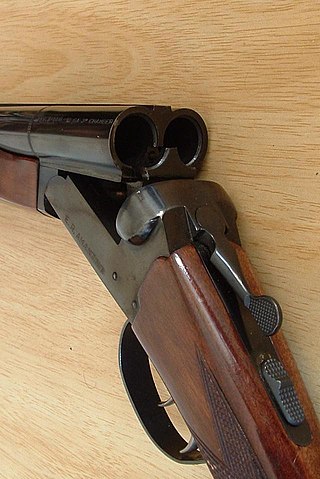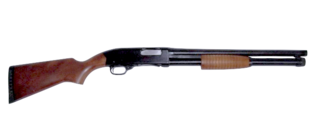The Winchester Model 1897, also known as the Model 97, M97, Riot Gun, or Trench Gun, is a pump-action shotgun with an external hammer and tube magazine manufactured by the Winchester Repeating Arms Company. The Model 1897 was an evolution of the Winchester Model 1893 designed by John Browning. From 1897 until 1957, over one million of these shotguns were produced. The Model 1897 was offered in numerous barrel lengths and grades, chambered in 12 and 16 gauge, and as a solid frame or takedown. The 16-gauge guns had a standard barrel length of 28 in (71 cm), while 12-gauge guns were furnished with 30 in (76 cm) barrels. Special length barrels could be ordered in lengths as short as 20 in (51 cm) or as long as 36 in (91 cm). Since the time the Model 1897 was first manufactured, it has been used to great effect by American military personnel, law enforcement officers, and hunters.
Savage Arms is an American gunmaker based in Westfield, Massachusetts, with operations in Canada and China, PRC. Savage makes a variety of rimfire and centerfire rifles, as well as Stevens single-shot rifles and shotguns. The company is best known for the Model 99 lever-action rifle, no longer in production, and the .300 Savage. Savage was a subsidiary of Vista Outdoor until 2019 when it was spun off.

The Mossberg 500 (M500) is a series of pump action shotguns manufactured by O.F. Mossberg & Sons. The 500 series comprises widely varying models of hammerless repeaters, all of which share the same basic receiver and action, but differ in bore size, barrel length, choke options, magazine capacity, stock and forearm materials. Model numbers included in the 500 series are the 500, 505, 510, 535, and 590. The Revelation 310 and the New Haven 600 were also variations of the 500 series produced by Mossberg under different names. By 2021, 11,000,000 M500s had been produced, making it the most-produced shotgun of all time.

The Smith & Wesson Model 29 is a six-shot, double-action revolver chambered for the .44 Magnum cartridge and manufactured by the United States company Smith & Wesson.
Thompson/Center Arms was an American firearms company based in Springfield, Massachusetts. The company was best known for its line of interchangeable-barrel, single-shot pistols and rifles. Thompson/Center also manufactured muzzle-loading rifles and was credited with creating the resurgence of their use in the 1970s.

Harrington and Richardson is an American brand of firearms and a subsidiary of JJE Capital Holdings. H&R ceased independent production February 27, 2015.
The Maverick 88 is a pump action shotgun manufactured for O.F. Mossberg & Sons. The Maverick 88 is virtually identical to the Mossberg 500. Factory Maverick 88s feature a black, synthetic only stock and forearm, cylinder bore, and cross-bolt safety. Most accessories not dealing with the trigger are interchangeable with a Mossberg 500.
The Stoeger Condor is a double-barreled shotgun. It is an over/under gun, with one barrel above the other.

Break action is a type of firearm action in which the barrel(s) are hinged much like a door and rotate perpendicularly to the bore axis to expose the breech and allow loading and unloading of cartridges. A separate operation may be required for the cocking of a hammer to fire the new round. There are many types of break-action firearms; break actions are universal in double-barreled shotguns, double-barreled rifles, combination guns, and are commonly found in single shot pistols, rifles, shotguns, including flare guns, grenade launchers, air guns, and some older revolver designs. They are also known as hinge-action, break-open, break-barrel, break-top, or, on old revolvers, top-break actions.

The Model 1200 is a pump-action shotgun that was manufactured by the Winchester-Western Division of Olin Corporation, starting 1964. It was redesignated the Model 1300 in 1978 with minimal changes. Production ceased in 2006 when the U.S. Repeating Arms Company, the subsequent manufacturer, went bankrupt. A militarized version of the Model 1200 was acquired by the U.S. Army for use during the Vietnam War. It is still in active service within various conflicts throughout the 21st century.
Perazzi is a manufacturer of precision shotguns from Brescia, Italy. The company sells hunting and sporting models of shotguns noted for their removable trigger groups, high quality, and high prices (US$7,500–$440,000). Its founder is Daniele Perazzi, and his family owns and operates it.

The M6 Aircrew Survival Weapon was a specially-made .22 Hornet over .410 bore combination gun issued to United States Air Force aircrews to help forage for food in the event of a plane crash. It was issued from 1952 until the early 1970s, in conjunction with the M4 Survival Rifle. Plans to replace both with the ArmaLite AR-5 never came to fruition and in 2018 was instead replaced with the GAU-5A Aircrew Self Defense Weapon in some instances.
The CZ 452 also known as BRNO Model Two .22 Rifle is a series of magazine-fed bolt-action rimfire repeating rifles manufactured by the Czech firearms manufacturer Česká Zbrojovka Uherský Brod and imported into the United States by CZ-USA. Most versions of the 452 rifle series were discontinued in 2011 and replaced by the CZ 455, although CZ continues to offer the CZ 452 American in a left-hand model, with the bolt handle and ejection port located on the left side of the rifle.

The Springfield Armory M6 Scout is a .22 Hornet over .410 bore combination gun that is virtually identical to the original M6 Aircrew Survival Weapon. It is also made in .22 Long Rifle over .410 bore and .22 Magnum over .410 bore. The Scouts are made with 18.25 inches (46.4 cm) barrels, as opposed to the original M6's 14 inches (36 cm) barrel length, to comply with National Firearms Act. The later models have large over-sized trigger guards and Picatinny rails for mounting a wide range of sights and scopes. They come in stainless steel or with a Parkerized finish.
The Remington Spartan 310 is a double-barreled shotgun. It is an "over and under" gun, with one barrel above the other. There are several different models, each of them chambered in various gauges.
The Stoeger Coach Gun is a side-by-side double-barreled shotgun. It is marketed and distributed by Stoeger Industries in Accokeek, Maryland. It is manufactured by E.R. Amantino (Boito) in Veranópolis, Brazil.
The CZ-550 is a bolt-action hunting rifle series manufactured by Česká zbrojovka Uherský Brod. The CZ 550 series is available with a medium or magnum sized action. The CZ 550 rifle is based on the Mauser 98 rifle.
Chiappa Firearms, Armi Sport di Chiappa, is an Italian firearms manufacturing company based in Brescia. It was founded in 1958 by Ezechiele Chiappa as Armi Sport. Total unit production is around 60,000 per year. Its U.S. headquarters are in Dayton, Ohio.

The Savage Model 24 is an American made over-and-under combination gun manufactured by Savage Arms. The basic .22LR over .410 gauge model weighs 7 pounds, has 24-inch barrels and has an overall length of 41-inches. It may also be disassembled for ease of storage.
The Stevens Model 520 was a pump-action shotgun developed by John Browning and originally manufactured by the J Stevens Arms & Tool Company between 1909 and 1916. Stevens was sold to New England Westinghouse on 28 May 1915 and production of civilian firearms was greatly reduced. The company was renamed the "J Stevens Arms Company" on 1 July 1916 and New England Westinghouse used their manufacturing facility in Chicopee Falls, MA to produce Mosin-Nagant rifles under contract for the Russian Czar during World War I. After the war, Stevens was sold to Savage Arms on 1 April 1920 and full production of civilian firearms resumed. Under Savage ownership, Model 520 production continued until 1939 when it was replaced by the Model 520A which ended production in 1948. Stevens also further modified the design when they introduced the streamlined Model 620 in 1927. The Model 620 was internally similar to the Model 520 and was produced until 1939 when it was replaced by the Model 620A which ended production in 1955. This shotgun is a hammerless, pump action, take-down design with a tubular magazine which holds 5 shells. All models can also be slam fired: the shotgun has no trigger disconnector and shells can be fired one after the other simply by working the slide if the trigger is held down.